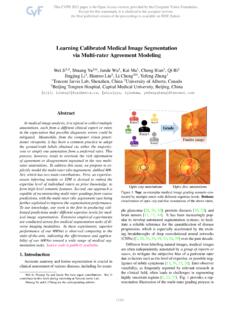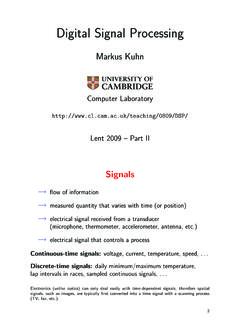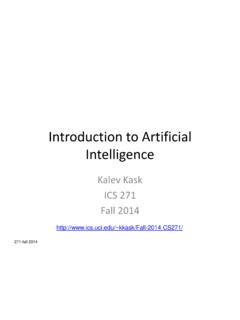Transcription of Deep Learning For Image Registration - Stanford University
1 deep Learning For Image RegistrationYiping LuSchool Of Mathmatical SciencePeking Registration is an important task in computer vision and Image process-ing and widely used in medical Image and self-driving cars. In this paper, wereviewed popular method in deep Learning for Image Registration , both supervisedand unsupervised IntroductionImage Registration is an important task in computer vision and Image processing and widely used inmedical Image and self-driving cars. We take optical flow, stereo matching and multi-modal imageregistration as an example in this 1: Typical tasks in Image Registration .(a) Stereo (b) Multi-modal Image Registration (c)OpticalFlow. Stereo:stereo takes two Image from left eye and right eye in to calculate the disparityand then we can get the depth of the object in the Image .
2 An example is demonstrated inFigure1(a). Multi-Modal Image :If we take images of an object by two modes(like CT and MRI).It s hard to keep the object at the same place of an Image . An example is demonstrated inFigure1(b). Optical Flow:optical flow takes two frame of a video in and we need to compute thedifference between two frame to demonstrate the object moving. An example is demonstratedin Figure1(c). Here color demonstrated the direction of the flow and the color depthdemonstrated the size of the Learning Course DatasetKITTI is an object detection and object orientation estimation benchmark consistsof 7481 training images and 7518 test images, comprising a total of labeled objects. Allimages are color and saved as png. In their dataset they have demonstrate the optical flow and stereomatching result of their data and you can utilize the data to evaluate your algorithms.
3 The officalwebsite of KITTI order to denote deep Learning method, the data in KITTI is far from enough. In[5], they give a new dataset using a computer graphics technique to simple fake data and sampleddata is demonstrated in 2: Two examples in flying things Traditional MethodsIn this section we will introduce the traditional methods to do Image Registration . All the problems isaim to calculate a mappingfin order to minimize||F(I1) F(I2 f)||HereFcan be any mapping that extracting the feature. To be simple, letFbe the identity the model here is hard, it may have a lot of solutions. Different regularization term isneeded. Horn-algorithm like algorithms. We summarize the algorithm in [1], which is a bench-mark method before deep Learning . The objective can be written as||I1 I2 f||+R(f)In order to calculate||I1 I2(f)||we utilizing a Taylor expansion and take the time axisinto (x+dx,y+dy,z+dz,t+dt) =I+ I xdx+ I ydy+ I zdz+ I tdt.
4 Ifwe let the x,y axis of the vector fieldfis denoted asu,vand if we takeI1=I2 fas aconstraint, we get theoptical flow constranitas I t=f ( I)and we rewrite the objective function as|| I t ( I)||+R(f)The regularization termRhere can be any regularization term used in Image processing likeTV, nonlinear TV, nonlocal TV and wavelets. Quasi-conformal Methods. We can consider the Registration field as a solution of theBeltrami Equation[2]. f z=g f zSome popular regularization forfcan be TV, nonlinear-TV and others. And if we controlthe value of||g||+|| g||, the deformation s angle variation can be controlled. The simplestexample is to letg= 0, the equation f z= 0means the mappingfis a conformal mappingwhich preserves the angle between two Optimal TransportOptimal transport is an method considering the Image as a probabilitydistribution and minimizinginf |x T(x)| #I1=I2and the problem can be relaxed to the probleminf |x y|d (x,y) # (x,y) =I1projy# (x,y) =I2In [3], calculating the relaxed optimal transport(which is a simple linear programming) andwe can get the Registration result.
5 Laplace Eignvalue[4] utilize the eignvalue of laplace operator = xx+ yyas an featureextractor for 3d point clouds and then utlizing a Registration methods. This is because theLaplace Eignvalue is invariant under isometric Supervised Learning MethodsIn the supervised Learning setting, a simple FCN like DeepLab[9] used in segmentation can be usedin optical flow, in [5] they call this method FlowNetSimple. However, it is possible to utilize thestructure of the problem of optical flow to design different structure for the Registration pipeline of the network design is demonstrated in Figure3. In short every stage is playing thefollowing usage Cost Volume: Calculate the correlation of different patches in an Image . Aggregation: Aggregate the correlation to the Registration method.
6 Differential Warp: Calculate the loss||I1 I2 f||We will introduce every block in each 3: Demonstration of the structure of FlowNet and pipeline for Image Correlation LayerThe correlation layer is like the fine scale Registration stage used in [1], which used a HOG operatorto extract the feature and do the fine scale , I would like to introduce the paper firstutilizing a deep Learning method for stereo matching problem, which gives a good example what the3correlation layer whats to do. [7] utilize a trained neural network to do the Registration instead of thehandcraft HOG operator. They cropped the images into different matches and then trained a neuralnetwork to judge whether the Image patches are from the same place. Formally the CNN we trainsatisfiesCCNN(p,d) =fneg(< PLeft9 9(p),PRight9 9(p+d)>)HerePLeft9 9(p)means to get a9 9patch form the left Image at positionpand neural net is listed inFigure4.
7 The layerL1,L2,L3is used for feature extraction and then using a MLP to judge whetherit is a negative example. The label that whether the patchs are good examples can be get from thelabeled disparity in the 4: [7] s method for stereo stead of calculating the correlation of the different patches in an Image , [5] calculate it in anend-to-end way. The "correlation" of two patches centered atx1in the first map andx2in the secondmap is then defined asc(x1,x2) = [ k,k] [ k,k] f(x1+ ),f(x2+ ) Herefis the feature extractor like a neural network and the computation of correlation doesn t needany parameters. The computation takesc (2k+ 1) Aggregation And RefinementAggregation is aimed to generate the optical flow by the fine scale Registration . This can be done by asimple FCN, for this step we need to aggregate the information in original Image and interpolatedregistration result(interpolated can be view as a deconvolution layer).
8 In [5], they use a simple U-Netlike decoder and in [8] they applied a 3 DCNN output of DCNN is always only a fine-grained localization and [9] utilize a CRF to address thelocalization challenge, producing accurate results and recovering the detail of the object CRF is aimed minimize the energy functionE(x) = i i(xi) + i,j i,j(xi,xj)Here i(xi)is the probability assigned with the label outputed by our DCNN and pairwise potentialis aimed to preserve the edge information and can be formulated as i,j(xi,xj) = (xi,xj)[ 1exp( ||pi pj||22 2 ) ||Ii Ij||22 2 ) + 2exp( ||pi pj||22 2 )]Here (xi,xj) = 1ifxi6=xjand zero otherwise and the benefit of the CRF module is demonstratein stead of utilizing CRF, the two stage methods, we want to develop an end to end Learning frameworkto do the refinement.
9 Recent years there are a lot of works going on this ways and I will introducesome of them 5: The score (1st row) and belief (2nd row) maps after each mean field iteration. Learned CRF: [10] utilized the unrolled CRF minimization as a layer of neural network andthis process can be autogradiented easily. Affinity Spatial Propagation Network: [11] denote a method that doing a linear propagationon an Image by learned coefficient from an Image . The propagation is row by row(or columnby column) calculation ashk,t= (1 pk,t) xk,t+pk,t hk,t 1 The pipeline is demonstrated in Figure6, the propagation weight is calculated by the guidancenetwork and then do the propagation by the formula above. In order to reduce the calculation,the propagation only utilize a weight matrix of three diagonal matrix and then propagationfour times(four direction each time) to do the refinement.
10 The refinement matrix can be usedin different tasks. [8] s method is very similar, they learn a guide network and multiply theguidance to the aggregated result and then follows a softmax to calculate the 6: Spatial Propagation Network. Spatial CNN: Spatial CNN which is proposed in [12], is a nonlinear version of SPN. Thebenefit of SCNN is that there is no need to calculate a affinity matrix which may lead tohigh computational cost, instead they add Relu non-linearity into the propagation so thatthe refinement can be learned.(Non-linear propagation method is well known in imageprocessing society.) Segmentation Aware Convolution: [13] proposed a method to do segmentation awareconvolution to sharpen the result. First they utilize a metric Learning methods to embed thepixels into another space in order to have semantic information.













![arXiv:2105.05633v1 [cs.CV] 12 May 2021](/cache/preview/6/1/2/8/2/0/d/8/thumb-612820d8df3e5b009babe51cf11c5c25.jpg)


